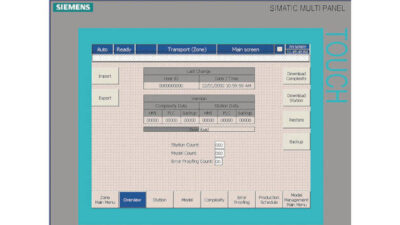Change management has long been a byword in manufacturing. Many won't think of altering a product design, bill of material, production line layout, inventory plan, or supply chain schedule without careful impact analysis or simulation. “Because we do government contracts, we can't simply allow buyers to make a substitution for a part specified in the manufacturing bill of material,”...
Change management has long been a byword in manufacturing. Many won’t think of altering a product design, bill of material, production line layout, inventory plan, or supply chain schedule without careful impact analysis or simulation.
“Because we do government contracts, we can’t simply allow buyers to make a substitution for a part specified in the manufacturing bill of material,” says Harry K. Butler III, support center management for EFW Inc. , a Fort Worth, Texas-based midsize defense electronics manufacturer that practices rigorous change management when it comes to manufacturing content.
Ironically, while IT organizations are instrumental in enabling manufacturers to implement and automate these practices, IT executives have been far more lax when it comes to managing change within their own shops. All too often, when a database administrator tunes a database or a data center technician alters a cache setting, the changes are administered without a formal approval workflow, and often go unnoticed unless an outage occurs.
When Toyota Motor Company spun off its financial services unit five years ago, the newly formed entity had the opportunity to start with a blank slate when it came to organizing IT. According to Dave Howard, national manager of business technology solutions for Toyota Financial Services , embedding formalized processes for delivering IT services became top priority. “We knew we would need some form of service management approach,” says Howard. “We found the ITIL framework was an excellent fit because it could scale, and it was not connected to any single vendor.”
The ITIL (IT Infrastructure Libraries) framework originated roughly 20 years ago when the British government’s telecommunications agency sought to audit its own operations in response to privatization challenges. Today, ITIL has evolved to a framework that codifies best practices for IT to follow as it delivers service to the business.
Where to start
Executing against the ITIL framework starts with reconfiguring the help desk—or Service Desk in ITIL parlance—into what amounts to a retail where customers shop for IT services. Accompanying the Service Desk, ITIL also supports processes for publishing Service Catalogs, providing price lists from which business can order services as their budgets and needs dictate. The Service Desk in turn takes full ownership for ensuring that requests for fixes or new services are fulfilled.
ITIL also covers configuration and change management under the assumptions that IT should have:
-
Full visibility into the configurations of assets and requirements of service contracts for which it is responsible;
-
Full responsibility for gauging the impact and making final approvals on changes to IT infrastructure; and
-
Formal processes for introducing new releases to production.
Once services are delivered, ITIL also defines processes for managing capacity, service availability, continuity, and tracking compliance with service levels that may be specified by formal agreements or contracts.
Yet while ITIL standardizes terminology and specifies the processes that comprise IT service management, it is not prescriptive of how to implement them.
“There is no such thing as an ITIL-compliant software product,” explains Rob Stroud, evangelist for IT service management and governance at CA , and a contributor to the ITIL framework. “One of the best things that ITIL has accomplished is it has brought a common vocabulary.”
Furthermore, with ITIL prodding IT groups to reinvent themselves as service delivery organizations, the result may be a new entrepreneurial mind-set. “The goal of developing a service strategy is to understand what the business needs and translate it to a service offering,” says Rick Lemieux, VP and sales and business development for training firm ITSM Solutions LLC .
Parallels with manufacturing
The similarities between ITIL and ERP implementations are striking, according to Don O’Toole, director of strategy for IBM ‘s Tivoli products.
“ITIL is about creating a discipline for improving efficiency of IT operations, just as you would implement SAP to improve the efficiency of your business.”
EFW’s Butler sees similarities drilling down to the process level. “If a systems administrator wants to change a setting on a server, they have to go through the exact same process that procurement would have to use if they wanted to change a part in a bill of material.”
Clearly, any veteran of a painful business process reengineering that preceded implementation of ERP could well sympathize with IT, as it approaches its moral equivalent with ITIL.
“Many [IT] people who don’t have this type of discipline will perceive this as additional overhead and ask, ‘Why do I need this, I’ve been doing this for years’ ” notes Toyota Financial’s Howard. “Service management adds a layer of accountability that a lot of people don’t want to have.”
Just as ERP covers a broad array of processes that support the management of a business, ITIL specifies processes for how IT manages its own business of delivering services. Furthermore, the new ITIL version 3 redrew service management around a concept that should look very familiar to manufacturers: the notion of managing a service throughout its life cycle.
“The new version focused on a bigger-picture approach to managing a service, as opposed to specific vertical tasks such as managing configuration items,” observes Ken Turbitt, best practices director for BMC Software .
Just as product life-cycle management seeks to unify processes from product conception through design, manufacture, operating life, and end-of-life disposal, ITIL version 3 specifies five distinct phases for managing an IT service, including service strategy, design, transition, operation and continuous improvement.
The chicken or the egg?
Given that the ITIL framework is extremely broad, most consultants recommend that IT organizations adopt a phased rather than “big bang” approach that addresses specific points of pain. One of the areas that might wait is the configuration management database (CMDB), the repository that is supposed to contain metadata, or pointers to external sources of metadata describing the configurations of current IT assets and services being managed.
“You should start wide and shallow with a CMDB, beginning with major servers or fixed assets, and drill down later to more specific items as the need arises,” recommends Dan Rueckert, HP Software’s WW practice for service management and security.
Establishing a CMDB is easier said than done. Lacking controls or discipline, managing a CMDB could become akin to boiling the ocean.
| Today, the ITIL (IT Infrastructure Libraries) has evolved to a framework that codifies best practices for IT to follow as it delivers service to the business. |
“It takes a good facilitator to manage a good CMDB,” notes Michelle Hudnall, director of service management for business service management specialist Managed Objects . In essence, keeping the CMDB manageable requires project management skills—as opposed to technical skills—because the manager must be able to ask why specific data is essential, as opposed to what it is. “He or she needs to think about how data might impact a specific domain, rather than specific attributes that apply to a given service or asset.”
Making IT customer-driven
For Toyota Financial Services (TFS), ITIL implementation began modestly with the help desk, establishing an operation that received calls, performed first-level support, and dispatched more complex requests upstairs. The next step was to replicate in their new distributed systems environment some of the change-management disciplines that the parent company had long practiced on the mainframe. The process was set in baby steps, focusing on specific areas that were pain points for the business. “Why should you gather [change] information that no one would otherwise do anything with?” asks Dave Howard, national manager of business technology solutions.
From there, TFS grew the help desk into a more active service desk that, in addition to performing higher-level support, also became what Howard termed the “retail store” for IT services. At the same time, change management processes were being gradually broadened to the point where today, any request that requires a modification or addition to the production environment must undergo a formal request process so that the impact of any change can be analyzed before it is approved.
In starting an IT operation from a blank slate, one of TFS’s major goals was to make it more customer-focused. Toward that end, the IT group actually appointed customer relationship managers, a move that was unusual for an internal group serving what would otherwise be considered a captive market. “We learned that people in IT were somewhat out of touch with what was going on in the business,” says Howard. “That raised our level of contact [with the business] up to the VP level.”
Since the unit embraced ITIL three years ago, major outages have been reduced from an average of two to three per week to about once every couple months. According to Howard, the careful planning of releases—in conjunction with formalized change management policies and a carefully structured problem management process that emphasizes root cause analysis—have allowed TFS to improve IT reliability.
As part of its ITIL processes, TFS also continually takes metrics on service desk/problem resolution, with the result that it can report to senior management reliable figures on productivity improvements attributable to faster response and reduced downtimes. “We’ve become a more strategic partner to the business,” says Howard.
This service desk is on steroids
Back in 2007, Fort Worth, Texas-based EFW Inc., a midsize defense electronics manufacturer, kicked off an acquisition strategy that has nearly tripled the size of the company to 2,000 employees. And in the wings, the company is about to digest another acquisition that will add 800 more to the staff.
Support Center Manager Harry Butler, himself a Six Sigma veteran, took an unorthodox approach when he decided to implement the ITIL framework. Rather than focus solely on IT, he expanded the Service Desk to cover all areas of internal operations support. Whether you forgot your password, needed to get some light bulbs changed, adjust health benefits, or upgrade a server, EFW employees now call one place. With a staff of eight supporting 14 sites, it’s not unusual if a facilities specialist initially fields an IT call. “The processes really weren’t all that different, whether it came to fixing a PC, replacing a toilet, or fulfilling a check request,” says Butler.
Not surprisingly, the support center originated as an IT operation. At the time, other areas such as facilities or HR did not have dedicated support staff. The result was, even if PCs could get fixed in a day, that wasn’t always the case with fixing machinery or getting HR response. “You typically had to leave voicemail,” recalls Butler.
Today the consolidated support center staff is heavily cross-trained. It has adopted ITIL processes covering service delivery, and encompassing service desk, problem and incident management, and change configuration management. Additionally, EFW has adopted ITIL processes associated with service support, including financial and capacity management, availability management, and service-level management.
According to Butler, while productivity benefits of reduced downtime or greater support center efficiency might be relatively easy to measure, the prime benefits are less tangible, such as the ability to fulfill a check request in four hours rather than three days. For the record, the support desk at EFW now handles roughly double the requests with the same staff compared to three years ago. But, added Butler, some of the benefits of applying ITIL are more strategic
“Some of our clients request that we use ITIL,” says Butler, noting that the same change configuration management processes applied to fixing employee computers also apply to product design changes for customers.



